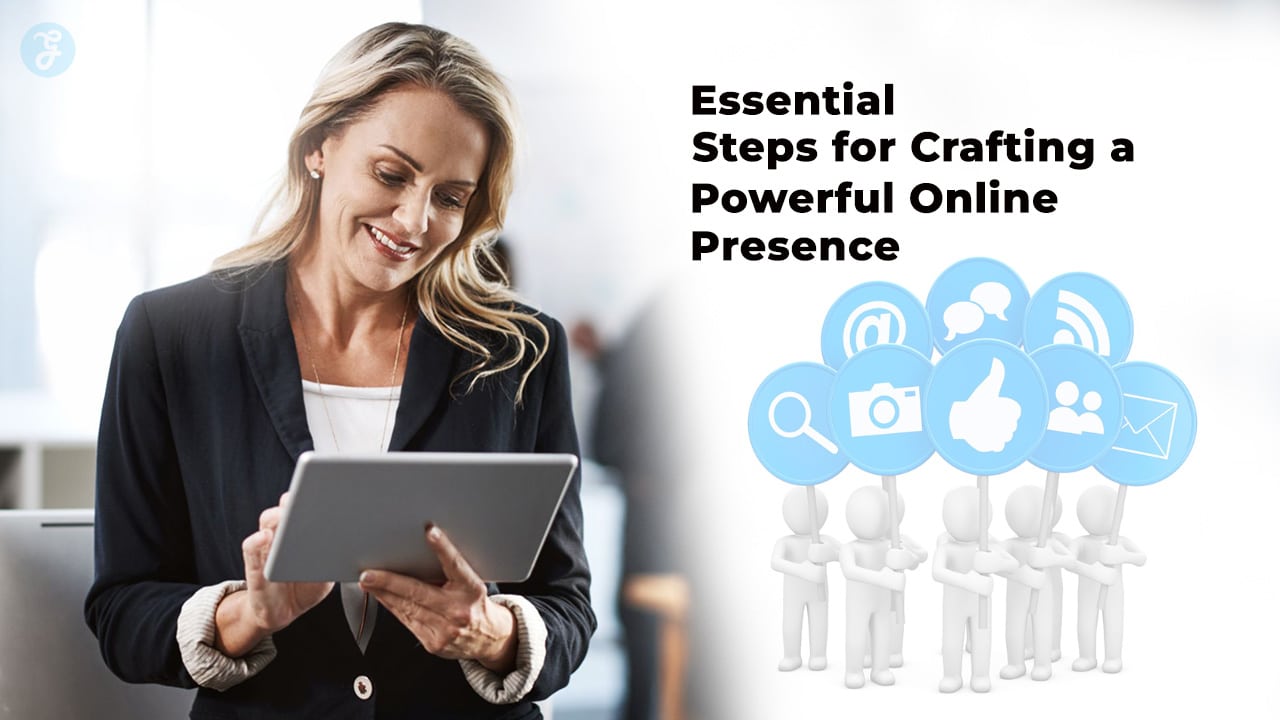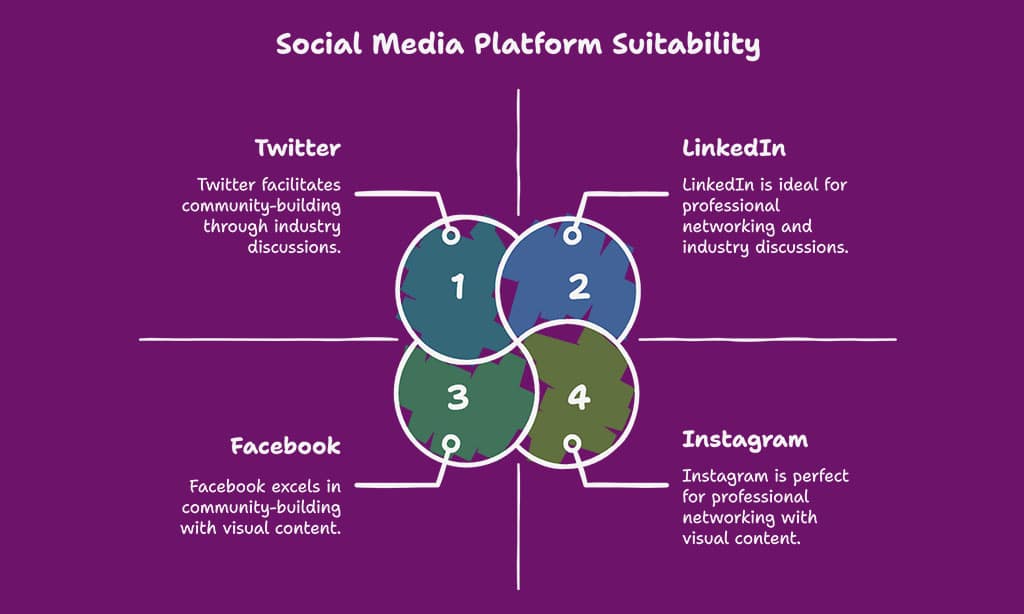In today’s fast-paced digital world, having a solid online presence is not just a luxury—it’s a necessity. Whether you’re a personal brand, small business, freelancer, or entrepreneur, your digital footprint directly impacts your visibility, credibility, and success.
However, with so many platforms and strategies available, it can be overwhelming to know where to start.
This article outlines the 7 essential steps for crafting a powerful online Presence. We’ll guide you through each critical step, providing detailed insights, practical tips, and real-world examples to help you build a strong and sustainable online identity.
By following these steps, you’ll be on your way to standing out in the crowded digital space.
Introduction to Building a Powerful Online Presence
An effective online presence isn’t just about having a website or social media accounts. It’s about curating and managing your digital image in a way that aligns with your goals, engages your target audience, and converts visitors into loyal customers or followers.
Your online presence is often the first impression others have of you—whether it’s potential clients, business partners, or customers. A strong digital footprint can be a game-changer, offering you opportunities for growth, influence, and success.
In this guide, we’ll walk through the 7 Essential Steps for Crafting a Powerful Online Presence, offering detailed advice and strategies to help you implement these steps effectively. From defining your brand identity to monitoring your online presence, each section is packed with valuable insights to help you navigate the complex digital landscape.
Step 1—Define Your Brand Identity
Creating a memorable and impactful online presence starts with defining your brand identity. This is the cornerstone of everything you do online. It determines how you position yourself, communicate with your audience, and differentiate from competitors.
Understand Your Target Audience
Before you can build your online presence, you need to know who you are speaking to. Understanding your target audience will guide your branding efforts and ensure that your messaging resonates with them.
Key Considerations:
| Factor | Details |
| Demographics | Age, gender, income, location, etc. |
| Psychographics | Interests, lifestyle, values, and pain points |
| Behavioral Data | Shopping habits, content preferences, and decision-making |
By understanding these factors, you can tailor your brand voice, tone, and content to appeal to your ideal audience, which increases your chances of fostering meaningful relationships.
Example: If you are a fitness coach, your target audience might be young professionals aged 25-40 who are looking for efficient workout routines. Understanding their challenges [e.g., time constraints] will help you create content that offers quick and easy fitness tips.
Develop Your Brand Values and Messaging
Once you know your audience, define your brand values and messaging. Your brand values are the guiding principles that influence how you interact with your audience, make decisions, and market your products or services.
Key Elements of Effective Brand Messaging:
- Clarity: Ensure that your messaging is clear and concise. Avoid jargon or vague language that can confuse your audience.
- Authenticity: Stay true to your brand’s personality and core values. Authenticity fosters trust.
- Consistency: Use the same tone, language, and values across all platforms to create a unified experience for your audience.
Real-World Example: Patagonia, an outdoor apparel company, has consistently integrated sustainability and environmental advocacy into their brand messaging. They use their platform to share stories about conservation efforts, positioning themselves as a brand that values environmental responsibility—a message that resonates deeply with their eco-conscious customers.
Step 2—Build an Effective Website
Your website is the heart of your online presence. It’s where potential clients, customers, and followers will go to learn more about you and your offerings. If your website doesn’t make a strong first impression, visitors may leave and never return.
Choose the Right Platform and Domain Name
Selecting the right platform to build your website is crucial. Platforms like WordPress, Wix, and Squarespace offer various features and levels of customization, catering to different needs.
Platform Comparison Table:
| Platform | Best For | Ease of Use | Customization | SEO Features |
| WordPress | Bloggers, businesses, e-commerce | Moderate | High | Excellent |
| Wix | Beginners and small businesses | Very Easy | Moderate | Good |
| Squarespace | Portfolio sites, creatives | Easy | Moderate | Good |
Once you’ve chosen a platform, pick a domain name that reflects your brand and is easy to remember. Keep it short, catchy, and relevant.
Focus on User Experience [UX] and Design
A user-friendly website is key to keeping visitors engaged. Poor website design can lead to high bounce rates and lost opportunities. Focus on UX (User Experience) to ensure that your visitors have a seamless and enjoyable experience.
UX Best Practices:
- Fast Load Times: Websites that load in under 3 seconds perform better in search rankings and user engagement.
- Clear Navigation: Organize your content in an intuitive way to help users find what they need quickly.
- Mobile Responsiveness: Ensure your site looks and functions well on mobile devices, as mobile traffic accounts for over half of global web traffic.
Example: Airbnb’s website offers a clean, intuitive design with simple navigation and quick-loading pages. Their website also adapts beautifully to different screen sizes, providing an excellent experience for users, whether on a desktop or mobile device.
Step 3—Optimize Your Website for Search Engines [SEO]
SEO is essential for making your website discoverable by search engines and users. If your website isn’t optimized for SEO, it will be difficult to attract organic traffic.
On-Page SEO Best Practices
On-page SEO refers to the elements you control directly on your website to improve its search rankings. This includes things like keywords, content structure, and meta tags.
Key On-Page SEO Strategies:
| SEO Element | Best Practices |
| Keywords | Research and place primary and secondary keywords naturally into content. |
| Title Tags & Meta Descriptions | Write compelling titles and descriptions with keywords. |
| Internal Linking | Link related pages and posts to improve navigation and SEO. |
Example: A well-optimized blog post on your website should include a targeted keyword in the headline, URL, and throughout the body content. For example, if you’re writing a blog post about “Essential Steps for Crafting a Powerful Online Presence,” make sure this keyword appears in key places for optimal SEO impact.
Off-Page SEO Techniques
Off-page SEO focuses on strategies outside your website that impact your rankings, like backlinks and social signals. A strong backlink profile can significantly improve your site’s authority and visibility.
Off-Page SEO Strategies:
- Backlinking: Focus on earning backlinks from authoritative websites in your industry. This can be done through guest blogging, partnerships, and PR efforts.
- Social Media Sharing: Content shared on social platforms can indirectly impact SEO by increasing traffic and engagement, which search engines value.
- Guest Blogging: Writing guest posts for reputable blogs allows you to showcase your expertise and earn backlinks.
Real-World Example: A well-known example of successful off-page SEO is HubSpot, which regularly earns backlinks from major websites like Forbes, Moz, and Harvard Business Review. This strategy has played a key role in making HubSpot a leader in the marketing software industry.
Step 4—Leverage Social Media Platforms
Social media platforms are powerful tools for engaging with your audience and amplifying your online presence. However, it’s essential to choose the right platforms based on your audience and goals.
Select the Right Platforms for Your Audience
Not all social media platforms are created equal. Each platform has its unique features and caters to different types of audiences. It’s crucial to focus your efforts on the platforms where your target audience is most active.
Popular Platforms to Consider:
| Platform | Best For | Audience | Content Type |
| Visual brands, influencers, lifestyle | Gen Z, Millennials | Images, Stories, Reels | |
| Professionals, B2B businesses | Executives, professionals | Articles, Networking, Jobs | |
| Community-building, advertising | Wide demographic, all ages | Posts, Videos, Groups | |
| Quick updates, industry discussions | Tech enthusiasts, journalists | Tweets, Polls, Threads |
Choose the platforms that best match your brand’s objectives and the type of content you create. For example, Instagram is perfect for brands in the fashion or food industries, while LinkedIn works best for B2B businesses.
Create a Content Calendar and Posting Strategy
Content consistency is key on social media. Create a content calendar to plan and schedule your posts in advance, ensuring that your messaging stays aligned with your overall brand strategy.
Content Calendar Tips:
- Plan Ahead: Use tools like Hootsuite or Buffer to schedule posts and maintain a regular posting cadence.
- Engage with Followers: Respond to comments, retweet, and share user-generated content to foster community engagement.
- Monitor Analytics: Track your social media performance to adjust your strategy and content type.
Example: Nike’s social media strategy is an excellent example of brand consistency. They share motivational content related to sports and fitness across platforms, ensuring their messaging remains unified and aligns with their audience’s interests.
Step 5—Engage with Your Audience Through Content Marketing
Content marketing is a powerful tool for engaging with your audience, building trust, and establishing your brand as an authority in your field. Creating valuable, relevant content will help you attract, educate, and convert leads.
Create Valuable and Relevant Content
To stand out online, your content must add value. Whether it’s through informative blogs, entertaining videos, or insightful webinars, focus on creating content that addresses the specific needs and interests of your audience.
Types of Content to Create:
| Content Type | Benefits |
| Blogs | Improve SEO, establish authority, attract organic traffic |
| Videos | Highly engaging, great for tutorials, product demos |
| Infographics | Easy-to-share, visually appealing, simplifies complex information |
| Webinars | Direct interaction with audience, builds trust |
Example: Moz, an SEO software company, is well known for its educational blog that provides actionable SEO tips, tools, and resources. This consistent delivery of valuable content has helped them build a large and loyal following in the digital marketing community.
Utilize SEO-Driven Content Strategies
To maximize your content’s reach, you need to incorporate SEO best practices. This includes conducting keyword research, optimizing your content for search engines, and using content formats that perform well.
Content SEO Tips:
- Use Long-Tail Keywords: These keywords are more specific and less competitive, making them easier to rank for.
- Create In-Depth Articles: Longer content [1,500+ words] tends to rank better on Google, as it is more likely to answer users’ queries comprehensively.
- Update Old Content: Refresh old articles with new information and keywords to improve rankings.
Example: Backlinko, a website dedicated to SEO education, regularly updates its guides and case studies. By combining valuable content with strategic SEO, they maintain a high rank for competitive search terms.
Step 6—Build a Strong Email Marketing Campaign
Email marketing is one of the most direct ways to connect with your audience. By offering value through emails, you can nurture relationships and drive conversions.
Develop an Effective Lead Magnet
A lead magnet is something valuable that you offer to your audience in exchange for their contact information. It could be an ebook, a checklist, a webinar, or any other resource that solves a problem for your target audience.
Effective Lead Magnets:
| Type | Purpose |
| E-books | Offer in-depth knowledge or solutions to a problem |
| Webinars | Provide direct, engaging learning experiences |
| Free Trials | Let users try your product or service before purchasing |
Example: HubSpot offers free marketing guides and templates in exchange for email sign-ups, which has helped them build an extensive email list of engaged prospects.
Segment Your Audience for Personalized Emails
Email segmentation allows you to send targeted messages to specific groups within your audience. By tailoring content based on interests, demographics, or previous interactions, you can improve open rates and conversions.
Segmentation Tips:
- Use Behavioral Data: Send targeted emails based on user actions like browsing history or past purchases.
- Personalize Subject Lines: Include the recipient’s name or other personal details to increase open rates.
Example: Amazon uses segmentation to recommend products based on past purchases, creating highly personalized email campaigns that drive sales.
Step 7—Monitor, Analyze, and Adjust Your Online Presence
Once you’ve implemented your strategies, it’s essential to monitor, analyze, and adjust your online presence regularly to ensure it continues to meet your goals.
Use Analytics Tools to Track Performance
To track the success of your online presence, use tools like Google Analytics, Social Media Insights, and SEMrush. These tools can help you measure traffic, user engagement, and conversion rates.
Key Metrics to Track:
| Metric | Importance |
| Traffic | Shows how many visitors are coming to your website |
| Bounce Rate | Indicates how many visitors leave without interacting |
| Conversion Rate | Measures how well your website turns visitors into customers |
Example: Using Google Analytics, you can identify which pages or blog posts are driving the most traffic. This data can help you create more of the content your audience loves.
Continuously Improve Your Strategies
Online trends and audience preferences evolve over time, so it’s crucial to adjust your strategies accordingly. Regularly review performance data, experiment with new approaches, and stay up-to-date with industry changes.
Ongoing Optimization Strategies:
- A/B Testing: Try different versions of your website or ads to see which performs better.
- User Feedback: Collect and act on feedback from your audience to refine your content and approach.
- Industry Trends: Stay current with trends in technology, marketing, and consumer behavior.
Example: Spotify constantly updates its algorithm and user interface based on customer feedback and industry trends, ensuring they stay relevant and competitive.
Takeaways: Strengthen Your Online Presence
Building a powerful online presence doesn’t happen overnight, but with consistent effort, strategic planning, and dedication, the results are well worth it.
These 7 essential steps for crafting a powerful online presence—from defining your brand identity to continuously monitoring and improving your digital footprint—will give you the tools and knowledge to succeed in today’s competitive digital landscape.
The key to long-term success is not just executing each of these steps once, but continuously refining and evolving your approach as your audience and the digital landscape evolve. Remember, crafting an impactful online presence is about creating authentic, meaningful connections with your audience and delivering value at every touchpoint.
As you move forward with your online presence, always keep the following tips in mind:
- Be Authentic: Authenticity is crucial in building trust and loyalty with your audience.
- Stay Consistent: Consistency in messaging, content, and engagement is key to standing out.
- Measure and Adjust: Regularly review your data to see what’s working and where you need to improve.
- Adapt to Trends: Stay updated with new technologies, trends, and best practices in digital marketing.
- Engage with Your Audience: Make your audience feel valued through direct interaction and personalized communication.
By committing to these steps and continuously improving your strategies, you can establish a strong and enduring online presence that not only draws traffic but also builds lasting relationships with your audience.














































